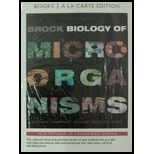
Brock Biology of Microorganisms, Books a la Carte Plus Mastering Microbiology with eText -- Access Card Package (14th Edition)
14th Edition
ISBN: 9780321948304
Author: Michael T. Madigan, John M. Martinko, Kelly S. Bender, Daniel H. Buckley, David A. Stahl
Publisher: PEARSON
expand_more
expand_more
format_list_bulleted
Concept explainers
Question
Chapter 15.12, Problem 2MQ
Summary Introduction
The largest genus of Actinobacteria is Streptomyces. Streptomyces are filamentous, aerobic, Gram-positive bacteria. It grows well in different environments such as soil. It is often called as
Streptomyces species plays an important role in the production of antibiotics. It produces numerous antibiotics such as streptomycin, neomycin, tetracycline, and clindamycin.
Expert Solution & Answer
Want to see the full answer?
Check out a sample textbook solution
Students have asked these similar questions
Why might antibiotic production be of advantage tostreptomycetes?
How are the spores of streptomycetes different fromendospores?
What is the economic importance of basidiomycetes?
Chapter 15 Solutions
Brock Biology of Microorganisms, Books a la Carte Plus Mastering Microbiology with eText -- Access Card Package (14th Edition)
Ch. 15.1 - What are some ways in which Wolbachia species can...Ch. 15.1 - Prob. 2MQCh. 15.2 - Prob. 1MQCh. 15.2 - Prob. 2MQCh. 15.3 - Prob. 1MQCh. 15.3 - Prob. 2MQCh. 15.4 - What species of Pseudomonas is a common cause of...Ch. 15.4 - What major characteristic could be used to...Ch. 15.5 - What four metabolic traits are most common in...Ch. 15.5 - Why is Wolinella physiologically unusual among the...
Ch. 15.6 - Prob. 1MQCh. 15.6 - How can Streptococcus pyogenes be distinguished...Ch. 15.7 - Prob. 1MQCh. 15.7 - What characteristics differentiate Sarcina from...Ch. 15.8 - What is the major physiological distinction...Ch. 15.8 - What is the crystalline protein made by Bacillus...Ch. 15.9 - Prob. 1MQCh. 15.9 - Prob. 2MQCh. 15.10 - What is snapping division and what organism...Ch. 15.10 - What organism is involved in the production of...Ch. 15.11 - What is mycolic acid, and what properties does...Ch. 15.12 - Prob. 1MQCh. 15.12 - Prob. 2MQCh. 15.13 - Prob. 1MQCh. 15.14 - Describe a method for isolating Cytophaga species...Ch. 15.14 - Prob. 2MQCh. 15.15 - How are Chlamydia and Mycoplasma (Section 16.9)...Ch. 15.15 - Prob. 2MQCh. 15.16 - Prob. 1MQCh. 15.16 - Prob. 2MQCh. 15.17 - Prob. 1MQCh. 15.18 - What is unique about the genome of Thermotoga and...Ch. 15.19 - Prob. 1MQCh. 15.20 - Describe a commercial application of Thermus...Ch. 15.20 - Describe an unusual biological feature of...Ch. 15.21 - Prob. 1MQCh. 15.21 - Prob. 2MQCh. 15.21 - Prob. 3MQCh. 15 - Prob. 1RQCh. 15 - Prob. 2RQCh. 15 - Prob. 3RQCh. 15 - What is the catalase test? What catalase reaction...Ch. 15 - Prob. 5RQCh. 15 - Prob. 6RQCh. 15 - Prob. 7RQCh. 15 - Prob. 8RQCh. 15 - Prob. 9RQCh. 15 - Prob. 10RQCh. 15 - REVIEW QUESTIONS
11. Describe a key feature that...Ch. 15 - Prob. 12RQCh. 15 - Prob. 13RQCh. 15 - Prob. 14RQCh. 15 - Prob. 15RQCh. 15 - Prob. 16RQCh. 15 - Enteric bacteria, lactic acid bacteria, and...Ch. 15 - Microorganisms can have a variety of different...
Knowledge Booster
Learn more about
Need a deep-dive on the concept behind this application? Look no further. Learn more about this topic, biology and related others by exploring similar questions and additional content below.Similar questions
- What is thalloid body of a slime mould (Myxomycetes) is known as?arrow_forwardWhich of the following is/are example(s) ofdeuteromycetes?(a) Alternaria (b) Colletotrichum(c) Trichoderma (d) All of these Please try to break the solutions into as many steps as practically possible and the steps should come one by one and they should be short and crisp and plagiarism-free.arrow_forwardWhy are zygomycetes called conjugation fungi?arrow_forward
- What are the characteristics of Actinomycetales? How do you recognize an actinomycete colony? How do you recognize Actinomycetales on a microscope slide?arrow_forward_____are fungi that live as intracellular parasites. a. Glomeromycetes c. Microsporidia b. Chytrids d. Club fungiarrow_forwardWhat characteristics of pathogenic fungi result in theirbeing efficiently transmitted?arrow_forward
- Describe the general characters of Basidiomycetes.arrow_forwardBesides organic compounds, of what benefit to the fungus is amutualism with Anabaena?arrow_forwardIn most_______ , an extensive dikaryotic mycelium is the longest-lived phase of the life cycle. a. chytrids c. sac fungi b. zygote fungi d. club fungiarrow_forward
arrow_back_ios
SEE MORE QUESTIONS
arrow_forward_ios
Recommended textbooks for you
 Concepts of BiologyBiologyISBN:9781938168116Author:Samantha Fowler, Rebecca Roush, James WisePublisher:OpenStax College
Concepts of BiologyBiologyISBN:9781938168116Author:Samantha Fowler, Rebecca Roush, James WisePublisher:OpenStax College

Concepts of Biology
Biology
ISBN:9781938168116
Author:Samantha Fowler, Rebecca Roush, James Wise
Publisher:OpenStax College